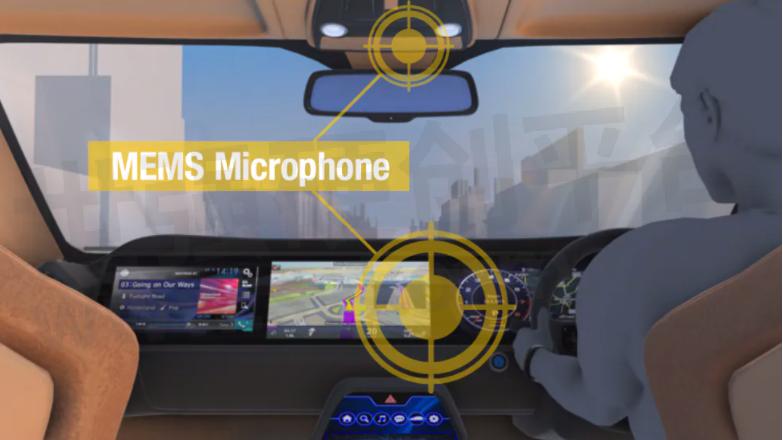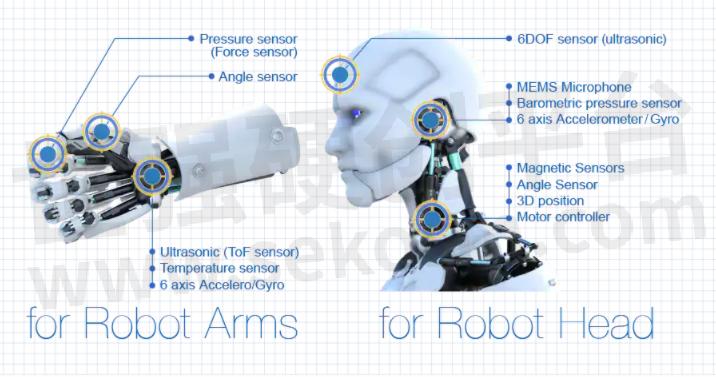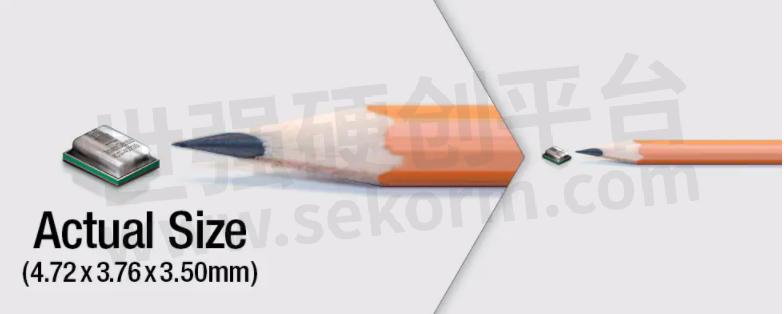TDK Provides MEMS Microphone Solutions for Expanding the Possibilities of Interactive Robots




Interactive robots using robotics and AI technologies such as smart speakers are being developed one after another. For voice recognition, which is a key technology for these interactive robots, multiple sophisticated and compact microphones are required to recognize the speaker’s voice against the background noise. TDK provides various ultra-compact MEMS microphones using advanced semiconductor microfabrication techniques, supporting the advancement of voice recognition technology and further improvement of the intelligence of interactive robots.
Technical Issues of Voice Recognition for Interactive Robots
Robots that perform operations instead of humans or support operations by humans are largely categorized into industrial robots and business/service robots. Business/service robots have been growing quickly recently, and it is expected that their world market size will reach 52 billion USD by 2025 (Source: “Reality and Future Outlook of Worldwide Robot Related Market 2018” by Fuji Keizai Co., Ltd.). Among business/service robots, the growth of interactive robots, in particular, is expected.
Interactive robots automatically interact with humans using AI. They can actuate movements, and/or speech in accordance with the interaction, and are expected to play a role in solving global social issues, such as aging societies and labor shortages.
The World Market Size for Business/Service Robots

Created based on “Reality and Future Outlook of Worldwide Robot Related Market 2018” by Fuji Keizai Co., Ltd.
The user interface for interactive robots is provided by voice recognition technology. Interaction robots need to detect the direction of the speaker even if he/she speaks from a distance and recognize his/her speech against background noise. As a solution, multiple microphones are installed to find the direction of the speaker from the differences between the times of arrival and the strengths of the voice received at the respective microphones. This technology is called beamforming. It is also required to remove noise components only from background noises coming from various directions with noise cancelling technology2 using multiple microphones.
To accomplish beamforming and noise cancelling, it is necessary to use multiple microphones that are compact and light as possible. On the other hand, to accurately recognize the speaker’s voice, a high S/N ratio3 is required. In general, however, the higher the S/N ratio is, the larger the dynamic range4 becomes. Microphones for interactive robots face the challenge of maintaining a high S/N ratio and suppressing distortion at the same time as being compact and light.
Voice Recognition Technology Solutions Using Compact MEMS microphones
TDK’s various MEMS microphones solve the problems of beamforming and noise canceling. The ICS-40730, which TDK provides under the InvenSense brand, is a compact and high-performance MEMS microphone. 4.72 x 3.76 x 3.50 mm in size, it features a high S/N ratio of 74 dBA and is suitable for a microphone array5 for beamforming. Even at a sound level of 105 dB, the ICS-40730 can suppress the distortion at a maximum of 0.6% to maintain a high S/N ratio. (The sound level that is considered noisy is 110 dB, such as the level of the noise under an elevated railway track when a train is passing.) It also significantly contributes to a noise-canceling function.
Example of beamforming using MEMS microphone array

The use of an array of compact microphones with a high S/N ratio enables beamforming technology that can separate a specific sound source and emphasize a specific sound among multiple sound sources.
In addition to the ICS-40730, TDK provides a lineup of MEMS microphones for various applications. TDK’s microphones are used for smartphones, notebook computers, tablets, wearable devices, and hearing aids as well as voice recognition interfaces incorporated in interactive robots and luxury cars. These microphones include MEMS components, which are acoustic sensors using MEMS technology—TDK’s core technology—and ASICs (Application Specific Integrated Circuit) in a single package.
MEMS microphones for robotic vehicles

The above picture shows a vehicle equipped with a voice recognition interface using MEMS microphones. Now we have entered the era of interaction with robotic vehicles, and voice recognition is expected to be a key technology in autonomous driving.
Robots have evolved to be more human-like. Humanoid robots are equipped with a lot of sensors to control the joints and the posture so that human-like movements can be achieved. In addition to MEMS microphones and various other MEMS sensors, TDK provides a variety of sensors such as angle/position sensors using semiconductor technology, thin film technology, magnetic technology, and temperature/pressure sensors using electronic ceramics technology, together with advanced software to support the development of robotics.
TDK’s sensors incorporated into humanoid robots

MEMS microphone “ICS-40730”

The ICS-40730 is a bottom-ported MEMS microphone with ultra-low noise and differential analog output. The ICS-40730’s 74 dB SNR and ±2 dB sensitivity tolerance make it an excellent choice for microphone arrays and voice command applications.
- |
- +1 赞 0
- 收藏
- 评论 0
本文由剑藏锋转载自TDK InvenSense News,原文标题为:Microphone Solutions for Expanding the Possibilities of Interactive Robots,本站所有转载文章系出于传递更多信息之目的,且明确注明来源,不希望被转载的媒体或个人可与我们联系,我们将立即进行删除处理。
相关推荐
InvenSense Announces SensorStudio 2.3 Supporting Dataflow-Based Custom Sensors
InvenSense, Inc. announced the new SensorStudio 2.3 release. SensorStudio 2.3 is the latest reiteration of InvenSense‘s sensor prototyping and development platform for the Internet of Things (IoT). The support of custom sensors allows IoT developers a wider range of physical and virtual sensors.
TDK to Showcase the Power of Its Advanced Sensor Solutions at Sensors Converge 2024
TDK sensor solutions help further the company’s vision of transforming designs into reality. At TDK’s Sensors Converge booth, attendees can interact with innovations in sound, motion, pressure, and more. TDK technology will come to life in the form of Ribbit the Robot, an interactive roaming robot showcasing the broad spectrum of TDK technologies in a single use case. Ribbit will chat with participants about new possibilities for applications in IoT, robotics, automotive, and beyond.
TDK Announces Worldwide Availability of a New Generation of MEMS Barometric Pressure Sensor Platform
TDK Corporation announces the worldwide availability of the InvenSense ICP-20100 platform, a new generation, feature-rich barometric pressure sensor, ideal for applications in smartphones, tablets, drones, and smart home appliances.
TE Connectivity(泰科)板装式压力传感器选型指南
目录- Board Mount Pressure Sensors
型号- MS4515,1220,MS5840-02BA,MS5536X,MS54XX,1240,MS5637X,MS5803X,MS4515DO,MS5837X,MS52XX,MS5805-02BA,1210,MS52XX C&T,MS5534C,MS5201-XD,47 SERIES,37 SERIES,MS5540C,MS5611-01BA,MS4525,MS4426,MS4425,MS5839-02BA,MS1451,43 SERIES,1230,MS4525DO,50 SERIES,MS1471,MS5541X,22 SERIES,23 SERIES,MS5535X,13 SERIES,17 SERIES,MS5607-02BA,MS8607,33 SERIES,MS5525DSO,27 SERIES
High-Performance Digital MEMS Microphone Standard Digital Audio Interface to Blackfin DSP
型号- EV_INMP441Z,INMP441
High-Performance Digital MEMS Microphone KRM5403-011010 with a Dimensions of 4x3xt1.2mm and Low Current Consumption
The KRM5403-011010 is a high-performance digital MEMS microphone with dimensions of 4 mm x 3mm x 1.2 mm, offering improved size and performance over the existing KRM5403-010010 model. Features include low power consumption (0.46mA typical, half of the previous model), high SNR, flat low-frequency characteristics, and low distortion.
TDK‘s Newest MEMS Microphone T5828 with SoundWire™ Functionality Offers 68dBA SNR and Acoustic Activity Detect
These high-performance microphones push the boundaries of microphone acoustic performance, providing advanced feature sets in small package footprints. T5828 offers a high AOP of 133dB SPL, a high SNR of 68dBA, and a wide dynamic range, ideal for environments that shift from very quiet to very loud.
ROHM Develops the Industry‘s Smallest* CMOS Op Amp Optimized for Smartphones and Compact IoT Devices
ROHM has developed an ultra-compact 1.8V - 5V, rail-to-rail CMOS operational amplifier (op amp) - the TLR377GYZ. It is optimized for amplifying signals from sensors such as temperature, pressure, flow rate, used in smartphones, small IoT devices, and similar applications.
ROHM Develops the Industry‘s Smallest CMOS Op Amp Optimized for Smartphones and Compact IoT Devices
ROHM has developed an ultra-compact 1.8V - 5V, rail-to-rail CMOS operational amplifier - the TLR377GYZ. It is optimized for amplifying signals from sensors such as temperature, pressure, flow rate, used in smartphones, small IoT devices, and similar applications.
TDK Extends Battery Life of Kaadas Smart Door Lock with SmartSonic™ Ultra-low-power Time-of-Flight Sensors CH201
TDK announces the successful integrations of the InvenSense CH201 ultrasonic Time-of-Flight sensors into the Kaadas K9-F smart door lock, enabling its face recognition functionality to automatically unlock for recognized users, which was recently launched into the consumer market.
Do You Know the Application of Hall Effect Sensors on Smartphones?
These general-purpose sensors have a wide range of applications, among which Hall-effect sensors in mobile phones and other mobile devices can be used to detect flip covers that are usually equipped with magnets.
电子商城
现货市场



































































































































































































登录 | 立即注册
提交评论